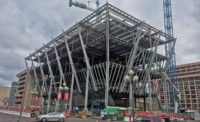 Guy Lawrence / ENR
|
The market for firms providing construction management on an at-risk basis has been booming for several years. Owners increasingly are attracted to the idea that employing a construction-management firm does not mean they have to assume the burden of all the risk.
For the ENR Top 100 Construction-Management-at-Risk Firms, 2007 was another big year. The Top 100 generated a total of $89.78 billion in revenue, up 21.2% from 2006. On the domestic side, the Top 100 had a combined revenue of $79.23 billion, up 17.0% over 2006, while revenue from projects outside the U.S. rose a huge 65.6%, to $10.55 billion. It continues to be the largest alternative project-delivery system by revenue measured by ENR and far and away the largest domestic system.
|
Like most in the industry, CM-at-risk firms are watching the economy with a wary eye. “In construction, we tend to lag the economy,” says Michael Kenig, vice chairman of Holder Construction Co. But he said that, while construction used to lag the economy by 18-24 months, with the accelerated pace of the construction process, firms will generally begin feeling the pinch in 12-18 months if there is a major downturn.
Some firms in the CM-at-risk market say that the volatility of materials prices over the past few years has given them an edge. “What clients are looking for are predictable outcomes,” says David Layton, CEO of The Layton Cos. “When you have the designer and the CM working together early on, you can develop strategies to manage materials price increases. This helps ease the inflationary pressures on a project.”
On a design-bid-build project, contractors will simply build in contingencies for materials price hikes, he claims. “If the inflation doesn’t materialize, the client has overpaid.” Many CMs agree. “In design-bid-build, the design team can create a budget for a project, but they don’t always have the experience and expertise on materials prices and trends that a contractor can provide,” says Jeff Gouveia Jr., executive vice president and general manager of Suffolk Construction.
 |
Currently, firms are seeing projects put on hold and finding project financ-ing takes longer. For some firms, it comes down to understanding not just the market as a whole, but the customer’s market. “It all comes down to the money stream,” says Gouveia Jr. “You have to understand how the client is going to market the project. As CMs, we sometimes can bring our own business expertise on marginal projects to help them become more viable.”
However, many CM-at-risk markets continue to be strong. “We probably do more data centers than just about anyone and that continues to be a strong market that’s almost entirely done on a CM-at-risk basis,” says Kenig. He also notes that higher education continues to be a hot CM-at-risk market, as is most of the public-sector building market.
“There’s a lot of education, healthcare, and institutional work available in the CM-at-risk market,” says Gouveia. He also notes that gaming continues to be strong. “There’s an awful lot of states with casino gambling measures on their ballots this year,” he says.
One market that has tanked is the multi-unit residential market in southern Florida. “We were lucky. We have offices in West Palm Beach, Miami and Sarasota,” says Gouveia. “We began transitioning out of the condo market about two years ago to take a run at the education market down there, so we weren’t hurt.”
For some projects, having a CM-at-risk firm can make a world of difference. “We have a three-part, $100-million project for the University of Utah Hospital in Salt Lake City,” says Layton. The 300,000-sq-ft job is to remove the helipad and add three floors to the parking garage before rebuilding the helipad, add two floors to an existing critical-care pavilion, and build a new five-story critical-care facility, all at the same time and while the existing facility continues to operate.
“We had 30 user groups within the hospital to communicate and coordinate with from the start,” says Layton. “It was logistically the most complicated project we have ever done, but it is going smoothly and predictably. You couldn’t do that on a design-bid-build basis.”
 The 2008 Top 100:
The 2008 Top 100: 

Post a comment to this article
Report Abusive Comment